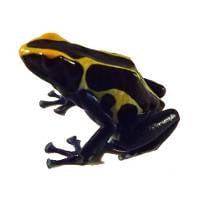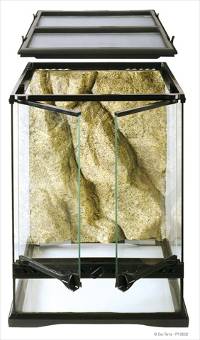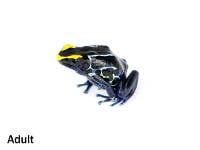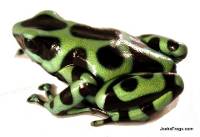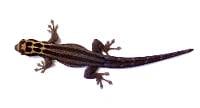Josh's Frogs
Why you should buy from us
Shield-Tailed Agama - Xenagama taylori (Captive Bred)
Shield-Tailed Agama - Xenagama taylori (Captive Bred)
$299.99 0.0 out of 5 stars
(0)
0.0 out of 5 stars
(0)About This Product
Defining Characteristics:
- Beautiful orange, tan, and brown coloration
- Diurnal
- Short, shield-like tail
- Active and curious lizard
- Rare, especially as captive bred animals
Name: Xenagama taylori, or the Shield-Tailed Agama. Their common name comes from its unusually shaped tail that flares out dramatically at the base, which is used to block the entrance of burrows at night. It's also known as the Turnip Tailed Agama and Taylor's Strange Agama.
Recommended Enclosure Size & Setup: A single adult or pair should be kept in at least a 24x18x18 enclosure, but this active, diurnal agama will appreciate and utilize more space if it is given. If setting up a colony, the enclosure size needs to be increased as more agama are added.
Shield-Tailed Agama are avid burrowers, and should have substrate no less than 4 inches deep, preferably around 6 inches. Substrate selected should retain moisture as well as be able to hold its shape well. Sand/soil or sand/coco fiber blends work well. It is also a good idea to add small amounts of clay, up to 5% by volume of the substrate blend, to aid with moisture and burrow retention. Zoo Med Excavator Clay is a good choice, as is Exo Terra Stone Desert. A semi-arid bioactive setup is strongly recommended for these agama.
Shield-Tailed Agama should be provided with plenty of hiding spots along with ample horizontal and vertical climbing material. Large cork bark flats and tubes, live oak bark, manzanita, and other branches will all be appreciated by this very active species. Partially submerging cage décor into the substrate is an excellent way to encourage burrow formation, but make sure that any décor added is firmly secured to either the bottom or sides of the enclosure itself, so that they are not crushed as they dig.
Temperature (°F) & Lighting: Keep Xenagama taylori around 80 degrees. A basking spot of around 110 - 120 degrees should be provided. Temperature should be monitored with a digital thermometer, and the hot spot should be checked with an infrared thermometer or temperature gun. Night temperatures should not fall below 65 degrees.
UV lighting is required. Shield-Tailed Agama are sun-worshippers that bask throughout the day in their native range. Not only do they synthesize vitamin D3 from exposure to UVB, they will also use the UVA wavelengths visible to all reptiles to properly inform basking behavior and circadian rhythm. UV lighting should be focused on their basking site and feature Ferguson zone 4 levels of UV radiation. Animals should also be provided opportunities to escape from UV exposure throughout the rest of their enclosure.
Humidity: Humidity is very important to Shield-Tailed Agama, and they should be provided a well ventilated setup with levels between 30-50%. Plants can be added to help stabilize higher humidity as well as provide humid microclimates. Ambient humidity should be monitored with a digital hygrometer. Shield-Tailed Agama should be misted every two to three days to provide dew on enclosure walls and cage items from which they can drink. A shallow water dish can also be provided.
These animals will burrow in their substrate - these burrows must be able to provide a humid microclimate for them to take advantage of.
Size: Shield-Tailed Agama are small, stout lizards. As adults, they can range between 3.5-4 inches long including their tails. Hatchlings are around 1 inch in length.
Age: Shield-Tailed Agama are at least 6 weeks old when sold by Josh’s Frogs, at which time they are well established. It is estimated that these lizards live for around 10-15 years in captivity..
Feeding: Shield-Tailed Agamas are omnivores, requiring both insect prey and vegetable matter. Diets for juveniles should be very insect-heavy, and need to be fed daily due to how high their metabolisms are. Adult diets can be slightly less insect-heavy and they can be fed slightly less frequently, but should still be fed 3-4 times a week, and have roughly 80% insects & 20% greens balance to their diet.
It is especially imperative to offer plenty of food if keeping multiple individuals together, as they will fight when resources are low.
Juveniles are large enough to take 1/8 inch crickets, or even 1/4 inch crickets. As they get older, they can be moved to 1/2 inch crickets. Dubia roaches are a great addition to their staple insect feeder rotation, while other appropriately sized feeder insects—waxworms and black soldier fly larvae—can also be occasionally offered. In general, Shield-Tailed Agama seem to favor smaller prey items than they can theoretically take down, and do better overall on a larger volume of small insects vs. a smaller volume of large insects.
Feeder insects should be gut loaded and dusted with a vitamin/mineral supplement; we recommend Repashy Calcium Plus LoD.
In addition to insects, fresh produce should be finely chopped up and offered a couple times weekly. Leafy greens high in nutrients should be staple, with other vegetables mixed in for variation. Avoid Iceberg and Romaine lettuce, as they are both lacking in nutrients. Knowing what greens and vegetables to offer can be tricky, and it is always best to consult a feeding chart before deciding what to feed. Definitely avoid avocado, citrus fruits, mushrooms, onion, and rhubarb, as they are all toxic.
Sexing: Males will blush a striking iridescent blue on and around their throat during mating season, but will otherwise have some faint blue present. Additionally, males as young as a month old (but more reliably around two months) develop a thick, yellow waxy coating on their femoral pores.
Shield-Tailed Agama sold by Josh’s Frogs are not sexed at the time of sale.
Color/Pattern: This species exhibits a wide range of base colors, mainly variations on tan. Individuals can range from yellowish to almost red. There can be varying patterns of white dots (primarily present in younger animals), and faint banding.
Social Behavior: Shield-Tailed Agama are regularly kept in larger groupings, with great success. Keeping multiple males together for lengthy periods of time can cause issues with the group’s social dynamics however, given that the males will compete for tank space, females, and resources.
This diurnal species can be intermittently seen basking and foraging throughout the day, but tend to be flighty. Their first usual response to their tank being disturbed is to flee into their burrows. As fast as they are in their enclosure, they tend to be rather calm when held, but handling sessions are best kept brief and infrequent to keep stress levels low.
Breeding: A 2 month brumation period is required to incite proper cycling. In addition to multiple females, multiple males are also required in order to breed taylori, as males need to engage in ritualistic mating displays in order to incite breeding interest.
In addition, proper substrate is especially important for breeding females. If they do not have an adequate region to deposit their eggs, and/or if they are not provided enough food or otherwise perceive strained resources, they will resorb their eggs and the clutch will be lost. If successful, the female will be noticeably gravid and lumpy for roughly 1-2 months, after which she will deposit 4-8 small oval-shaped eggs in moist, warm substrate. Taylori can usually be expected to lay 2-3 clutches per season when healthy.
Natural Range: Xenagama taylori, alongside the other 3 members of the Xenagama genus, are not a very widely distributed animal, being primarily found in the arid lowlands of Ethiopia and Somalia, although can occasionally extend up into the Ethiopian highlands.
History in the Hobby: These animals have been imported into the pet trade en-masse in the past. In the last 10 years, they have become very difficult to find, especially as captive bred animals.
Shipping
After placing an order containing a live animal, you will receive a scheduling email containing our JotForm scheduling link to schedule your new pet's delivery date.
With this scheduling link, you will be able to schedule your order's delivery up to 30 days in advance. You will be able to choose a date of delivery for Tuesday-Saturday (Saturday arrival depends on the carrier's service availability) with the estimated time of arrival generally being 12pm, or 4:30pm for more rural areas. Overnight lows must be above 40°F to ship directly to you (or above 30°F for FedEx Ship Center pickups) as well as below 90°F by estimated time of arrival.
If you require further assistance, or prefer to talk to one of our Customer Service agents, please feel free to reach out to our [email protected] email or our phone line 1-800-691-8178.
Other Customers Also Bought
Customer Reviews
0.0 out of 5 stars
Review data
5 star reviews
- 0%
4 star reviews
- 0%
3 star reviews
- 0%
2 star reviews
- 0%
1 star reviews
- 0%


